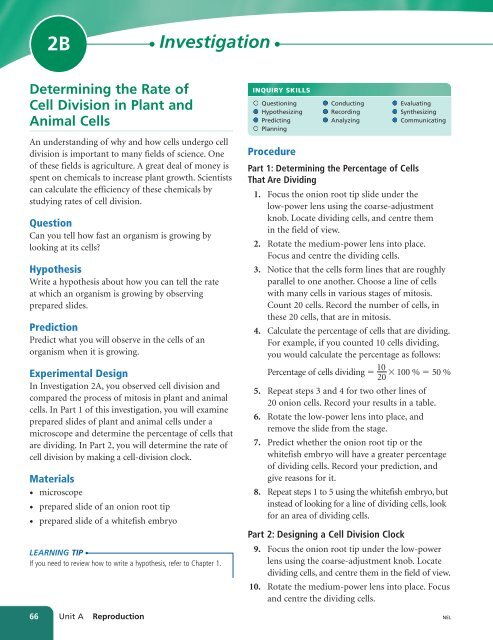Unit A Reproduction
Unit A Reproduction
Unit A Reproduction
Create successful ePaper yourself
Turn your PDF publications into a flip-book with our unique Google optimized e-Paper software.
2B<br />
Investigation<br />
Determining the Rate of<br />
Cell Division in Plant and<br />
Animal Cells<br />
An understanding of why and how cells undergo cell<br />
division is important to many fields of science. One<br />
of these fields is agriculture. A great deal of money is<br />
spent on chemicals to increase plant growth. Scientists<br />
can calculate the efficiency of these chemicals by<br />
studying rates of cell division.<br />
Question<br />
Can you tell how fast an organism is growing by<br />
looking at its cells?<br />
Hypothesis<br />
Write a hypothesis about how you can tell the rate<br />
at which an organism is growing by observing<br />
prepared slides.<br />
Prediction<br />
Predict what you will observe in the cells of an<br />
organism when it is growing.<br />
Experimental Design<br />
In Investigation 2A, you observed cell division and<br />
compared the process of mitosis in plant and animal<br />
cells. In Part 1 of this investigation, you will examine<br />
prepared slides of plant and animal cells under a<br />
microscope and determine the percentage of cells that<br />
are dividing. In Part 2, you will determine the rate of<br />
cell division by making a cell-division clock.<br />
Materials<br />
• microscope<br />
• prepared slide of an onion root tip<br />
• prepared slide of a whitefish embryo<br />
LEARNING TIP<br />
If you need to review how to write a hypothesis, refer to Chapter 1.<br />
INQUIRY SKILLS<br />
Questioning<br />
Hypothesizing<br />
Predicting<br />
Planning<br />
Procedure<br />
Conducting<br />
Recording<br />
Analyzing<br />
Evaluating<br />
Synthesizing<br />
Communicating<br />
Part 1: Determining the Percentage of Cells<br />
That Are Dividing<br />
1. Focus the onion root tip slide under the<br />
low-power lens using the coarse-adjustment<br />
knob. Locate dividing cells, and centre them<br />
in the field of view.<br />
2. Rotate the medium-power lens into place.<br />
Focus and centre the dividing cells.<br />
3. Notice that the cells form lines that are roughly<br />
parallel to one another. Choose a line of cells<br />
with many cells in various stages of mitosis.<br />
Count 20 cells. Record the number of cells, in<br />
these 20 cells, that are in mitosis.<br />
4. Calculate the percentage of cells that are dividing.<br />
For example, if you counted 10 cells dividing,<br />
you would calculate the percentage as follows:<br />
Percentage of cells dividing 10 100 % 50 %<br />
20<br />
5. Repeat steps 3 and 4 for two other lines of<br />
20 onion cells. Record your results in a table.<br />
6. Rotate the low-power lens into place, and<br />
remove the slide from the stage.<br />
7. Predict whether the onion root tip or the<br />
whitefish embryo will have a greater percentage<br />
of dividing cells. Record your prediction, and<br />
give reasons for it.<br />
8. Repeat steps 1 to 5 using the whitefish embryo, but<br />
instead of looking for a line of dividing cells, look<br />
for an area of dividing cells.<br />
Part 2: Designing a Cell Division Clock<br />
9. Focus the onion root tip under the low-power<br />
lens using the coarse-adjustment knob. Locate<br />
dividing cells, and centre them in the field of view.<br />
10. Rotate the medium-power lens into place. Focus<br />
and centre the dividing cells.<br />
66 <strong>Unit</strong> A <strong>Reproduction</strong><br />
NEL

















